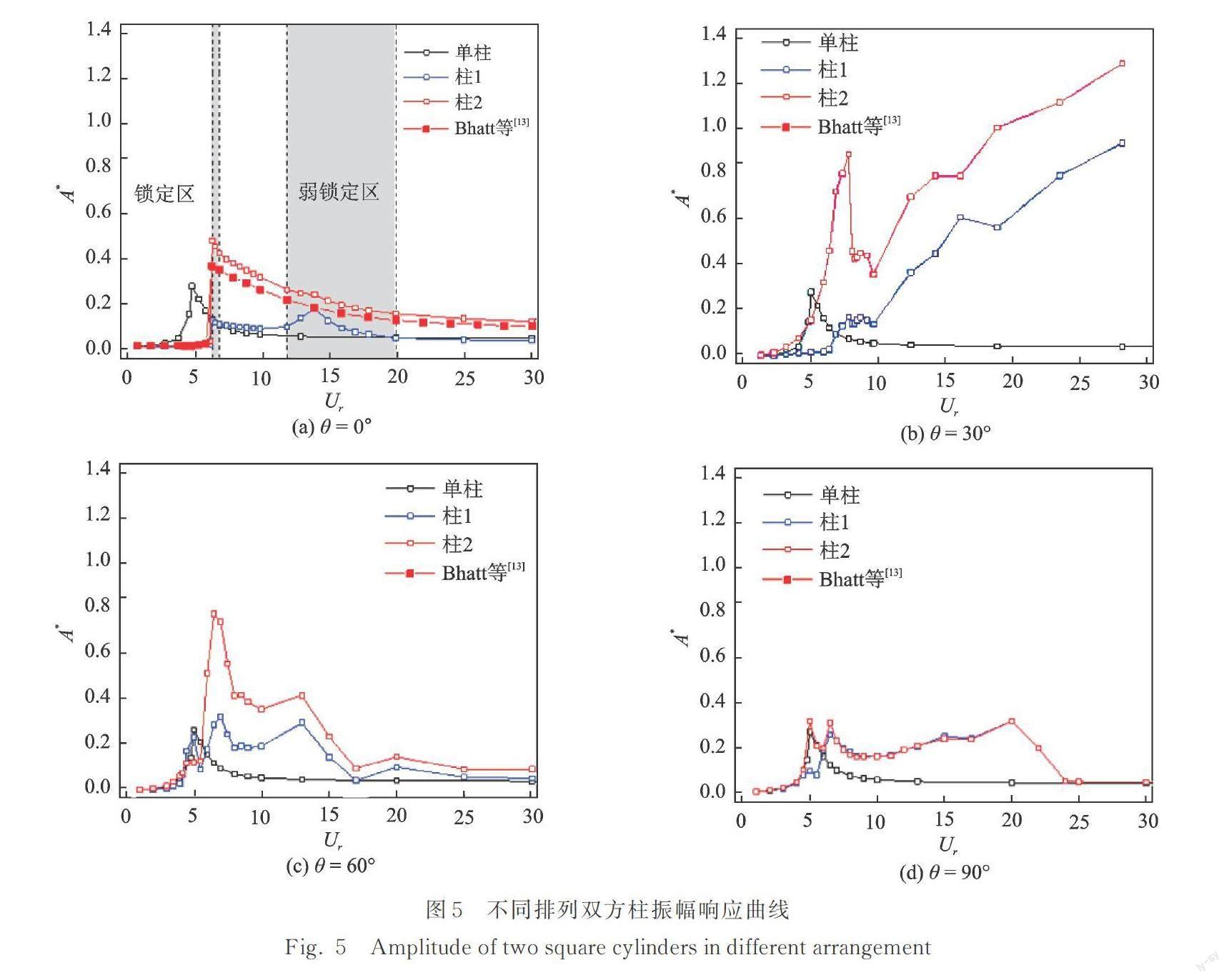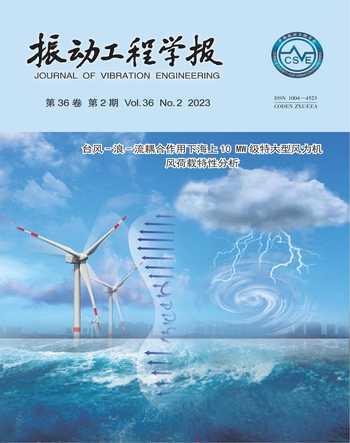不同排列小间距双方柱涡激振动数值模拟研究
邬益东 李海泉 王晓欣 史力 吴莘馨



摘要 为研究不同排列下小间距双方柱涡激振动特性及其振动机理,在雷诺数为100时,对间距比为2、质量比为3的串列、错列和并列排列双方柱涡激振动进行数值模拟研究,分析了双柱在折合流速Ur=1~30下的响应振幅及频率特性,并得到振动柱体的升阻力系数,以了解其气动力系数的变化情况,探讨了不同排列下双柱尾流结构的变化情况。结果表明:串列及错列排列中,下游柱涡激振动振幅远大于单柱,上游柱振动受到抑制(θ=60°的双方柱排列情况除外)。并列排列中,双柱振动曲线几乎一致,其涡激振动振幅比单柱稍大。各排列双柱均发生尾流驰振现象,使其在Ur超出共振区时仍保持较高的振幅。不同排列的的双柱阻力系数CD(θ=30°的双柱排列下游柱除外)均在共振区内突增,在共振区外保持不变。在共振区内,双柱CLrms随Ur的变化情况与A*的大小有关;在其余Ur范围内,双柱CLrms基本不变。串列双柱存在3种尾流模式,θ=30°双柱排列的尾流模式与串列双柱相似,但在超出共振区时,其尾流呈现无序状态。在θ=60°,90°双柱排列中,当Ur较大时,双柱尾涡结构呈现混乱的状态;当Ur较高时,柱体各自独立脱落旋涡。
关键词 涡激振动; 双方柱; 串列; 错列; 并列
引 言
流致振动在许多工程应用中是个重要的问题,其中均匀流中的圆柱或方柱是流致振动的研究热点之一。已有许多学者对圆柱[1?6]以及单个方柱[7?8]的涡激振动进行了系统的研究,获得了结构发生共振的条件,并用于指导工程设计。对于双方柱涡激振动,由于影响因素众多,其振动现象及机理的研究较为有限。
流体流经柱体后尾流的形式及其变化会显著地影响结构振动特性,针对固定双方柱绕流的研究已比较成熟,Sakamoto等[9]对不同柱间距(L/D=2.5~41,其中L为柱心的来流方向间距,D为方柱边长)的串列双方柱进行了研究,根据其斯特劳哈尔数St的分布将串列双方柱的柱间流态分成三类。第一类为L/D<4时,此时上游柱的旋涡被压制;第二类为4
相比固定柱,对于弹性支承双方柱的流致振动研究则十分有限,且大多数研究集中在数值模拟方面。Bhatt等 [13]研究串列排列下固定方柱对下游方柱振动的影响,发现当柱间距较小时(L/D=2),下游柱涡激振动发生在较大的流速下,其振幅大小不变;当柱间距较大时(L/D=6),下游柱的涡致振动振幅增大。Han等[14]和Nepali等[15]在Re=40~200时,对上游方柱固定、下游方柱具有雙自由度及双方柱均具有双自由度的两种情况进行了数值模拟,在串列双方柱柱间距为5D时,研究了雷诺数对柱体振动特性及流场结构的影响。杜晓庆等[16?18]对Re=150下的串列双方柱进行了数值模拟,研究了柱间距(L/D=2,4)、质量比(m*=3,10,20)对双柱振动及流场特性的影响。Guan等[19?21]在Re=200, m*=10时,对刚性连接的并列双方柱进行数值模拟研究,发现了并列双柱系统的四种振动模式。
双方柱涡激振动的问题仍有许多方面尚需进一步研究,尤其是错列双方柱情况。双柱间距较小时,其尾涡相互之间的影响较大[11],综合考虑数值建模的可行性,本文在柱间距为2D的情况下,对横向自由振动的不同排列双方柱进行数模拟研究,得到不同折合流速下双方柱的振动响应,同时研究不同排列下双方柱气动力特性及流场结构的变化。
1 数值计算模型
1.1 基本控制方程及柱体运动方程
计算流体力学的基本控制方程为:能量方程、运动方程及连续性方程。本文不考虑流体温度的变化,流体视为不可压缩的黏性流体,因此主要的控制方程为连续性方程及运动方程。
连续性方程:
式中 ui为流体的速度分量。
运动方程(N?S方程):
式中 ρ为流体的密度,视为常数;p为流体压强;μ为流体的动力黏度系数。
双方柱的计算模型如图1所示。其中,柱体边长为D,柱心间距P=2D,柱心连线与x轴方向的夹角为θ,U为来流速度,与x轴同方向。下标1代表为位于原点O左(下)方的柱体1,下标2代表为位于原点O右(上)方的柱体2。双柱仅在y方向上自由振动,柱体的运动方程为:
式中 y为柱体的位移;c为柱体结构阻尼;k为弹簧刚度;m为柱体单位长度质量;FL(t)=0.5ρU2DCL为柱体受到的y方向流体力分量,其中,CL为升力系数。
为方便观测不同排列下双柱结构与流体之间的相互作用,选取m*=3,c=0作为柱体的结构参数,以保证柱体的振动幅度足够大。
1.2 边界条件及网格划分
基于数值计算软件Fluent,对双方柱的涡激振动进行数值模拟,计算域的设置如图2所示。来流为均匀平行来流,流速为U,雷诺数Re=100。在该雷诺数下,认为三维效应影响很小[22?23],且来流为层流。同时,低雷诺数下观测到的涡激振动(VIV)行为也能较好地预测高雷诺数下的VIV行为[24]。入口边界采用速度入口边界,距柱体中心距离为25D。出口采用压力出口边界条件,距柱体中心50D。上下边界距离为40D,采用对称边界条件,柱体表面设为无滑移壁面。
采用嵌套网格技术进行数值模拟,该技术能克服动网格易出现负体积网格的问题,可以适应复杂的结构运动,能在结构运动的过程中保持较好的网格质量。文献[25?26]表明,嵌套网格技术在工程运用的数值模拟中能提供较高的准确度。计算模型的网格如图3所示,背景网格和部件网格均采用结构化网格。求解器采用基于压力的压力耦合求解器,算法为Couple算法。考虑计算结果的精度,采用二阶迎风格式进行空间离散、一阶隐式格式进行时间离散。柱体运动方程的求解采用四阶龙格?库塔法并通过UDF实现。
1.3 网格参数
以Re=100,θ=0°的串列双方柱静态绕流为研究算例,研究网格密度、计算时间步长对数值计算结果的影响,不同参数下固定串列双方柱绕流的计算结果如表1所示。其中CLrms为升力系数均方根(本文中的均方根均为数据除去直流信号(即减去平均值)后的取值,下文中yrms也如此),CD为平均阻力系数。考虑计算时间成本和计算结果的准确度,选取网格数为74294的网格模型,时间步长取0.01。
1.4 数值计算模型的验证
选取Re=100,m*=3,c=0的单方柱为算例,其静态绕流计算结果与文献的比较如表2所示。进行方柱单自由度自由振动的模拟,通过改变方柱的自振频率从而改变折合流速,得到方柱的涡激振动响应曲线,如图4所示。图4中,折合流速Ur及无量纲位移A*可由下式计算:
式中 fn为柱体的自振频率;yrms为柱体位移y的均方根。
由表2及图4可以发现,固定柱绕流各项参数和振动响应的振幅曲线均与其他文献的结果十分接近,验证了数值计算模型的准确性。
2 计算结果与分析
双方柱涡激振动的数值计算在Re=100,m*=3,ζ=0,P/D=2的条件下展开,考虑四种不同位置的双方柱排列(θ=0°(串列),30°,60°,90°(并列)),计算的折合流速范围为1~30,每个算例都经过足够长时间的计算以保证柱体达到稳态响应。
2.1 振动响应特性
不同排列双方柱的A*随Ur的变化情况如图5所示,单方柱的计算结果也在图中给出以进行比较。当双方柱呈串列(θ=0°)排列时,与单方柱相比,初始分支时,双柱的振幅被抑制;下端分支时,上游柱(柱1)涡激振动振幅被抑制,下游柱(柱2)则相反。下游柱振幅曲线仅在Ur=6.5出现一个峰值,该折合流速比单柱共振发生时的折合流速(Ur=5)略大。上游柱在Ur=6.5,14处出现两个峰值,且第二个峰值比第一个峰值稍大。当Ur >20时,上游柱的振幅与单柱接近,而下游柱仍保持较大的振幅。图5中给出相同条件下,处于固定上游柱尾流中的下游柱的振幅响应[13]。对比可以得出结论,上游柱的振动增大了尾流作用于下游柱的强度,使得下游柱的振幅增大。当θ=30°时,下游柱初始分支的振幅急剧增大,其峰值约为单柱的3倍多,对应的折合流速Ur=8。当Ur>10时,下游柱的振幅随着流速的增大迅速增大,出现类似于驰振的振动现象。该现象在串列双圆柱的涡激振动研究中也被观测到[30],其被称为尾流驰振。上游柱的振动响应与下游柱类似,但上游柱Ur=8处的峰值较小,且其整体振幅均比下游柱小。当θ=60°时,双柱振幅曲线均在Ur=6.5,13处出现两个峰值,上游柱的两个峰值一样大,下游柱振幅曲线的第一个峰值约为第二个峰值的2倍。当θ=90°时,双柱在Ur=5处振幅有所不同,上游柱出现较大的振幅,而下游柱振幅偏小。除此之外,雙柱振幅曲线基本一致,均在Ur=6.5,20处出现峰值,且两个峰值大小相差不大。下文将结合流场情况对对称的并列双柱结构出现不同振幅的情况进行解释。
图6为不同Ur下串列双方柱振动位移的无量纲功率谱密度(PSD)。对比双柱的功率谱密度,可以发现双柱振动频率基本一致。当Ur<12或Ur>20时,双柱均以单一的频率振动;当12 图8为不同Ur下其他排列双方柱振动位移的无量纲PSD。由于同一排列的两个方柱振动频率分布类似,因此图中只给出了柱1振动位移的PSD。对于θ=30°的双方柱排列情况,在Ur<10的范围内,柱体主要的振动频率不变,这是由于旋涡脱落导致的振动频率。当Ur>10时,柱体发生与串列排列10 2.2 气动力特性 图9给出了不同排列双方柱CD随Ur的变化情况。对于串列双方柱排列情况(见图9(a)),当Ur<5.5时,双柱CD基本保持不变,下游柱CD2由于上游柱尾流区的负压作用而出现负值[9]。当共振发生时(Ur=6.5),CD1突增,之后随着Ur的增大逐渐增大,超出共振区后又缓慢减小至定值。CD2在Ur=6.5时突增至最大值,且其值由负数转为正数,之后逐渐减小。由于柱2相对于柱1较大的振幅,使柱1失去“遮挡”作用,柱2离开柱1尾流的负压区,直接暴露在来流中,CD2变成正值。柱2与柱1的相对位移决定了柱2离开负压区的前表面面积,相对位移越大,柱2在负压区外的前表面面积越大,CD2越大,因此CD2随Ur的变化趋势与A*2一致。图9(b)给出了θ=30°时双方柱CD情况,CD1的变化趋势与θ=0°时的情况类似。当Ur<5,CD2比CD1稍大;在共振区(5≤Ur≤8)内,CD2突增,其值一直保持在较大值;超出共振范围时,CD2呈现断崖式下跌,之后随着Ur增大渐渐减小。对于θ=60°的双方柱排列情况(见图9(c)),CD1曲线除了在共振区出现一个峰值外,在其他Ur处均接近于定值,该值比其在θ=0°,30°时要大。CD2未达到共振区时接近于1.5,在共振区内,CD2先减小至最小值,而后迅速增大至最大值又急速减小。在Ur超出共振区时,CD2没有太大的变化。当双柱处于并列排列时,双柱CD曲线(见图9(d))十分相似,仅在共振区的发展有所不同。共振区外,双柱CD均保持在一定值附近;共振区内,CD1先减小后增大,CD2则先增大后减小。 图10给出了不同排列双方柱CLrms随Ur的变化情况,将其与图5中A*随Ur的变化情况作对比,可以发现A*与CLrms之间的关系。不同排列下双方柱A*受涡激振动和尾流驰振的影响。可以发现,涡激振动发生时,A*与CLrms成正比关系,图10中各CLrms曲线的峰值都能在图5中一致的Ur处发现相应的振幅曲线峰值。尾流驰振发生时,其CLrms有一定程度的增大,但其大小与A*无关。θ=30°的双方柱排列中,当Ur>10时,虽然A*随Ur的增大而增大,但其CLrms基本保持不变。并列排列中,双方柱A*曲线在10 2.3 流场结构特征 图11为串列排列双方柱的三种尾流结构。当Ur≤6.3时,双柱尾流结构如图11(a)所示,由于双柱振幅均较小,其尾流较稳定,脱落的旋涡涡度较小,下游柱背风面出现正反旋涡共存的两条平行涡街,其涡街在下游距柱体较远处转变为“2S”模式。当6.3≤Ur≤7.5,此时双柱处于旋涡脱落共振状态,振幅较大,尾流结构如图11(b)所示。下游柱由于大幅度的振动,周期性地交替脱落强度较大的正反旋涡,且正反旋涡横向间距较大。旋涡在远离柱体时,强度逐渐减小,正反旋涡之间的影响也减小,同向旋涡渐渐连成一片,形成两条平行的涡街。当Ur≥7.5时,双柱尾流呈现“2S”模式,如图11(c)所示。由于下游柱振幅的降低,脱落的正反旋涡横向间距减小,其横向间距不足以形成两条平行涡街,因此呈现“2S”模式。 θ=30°的双方柱排列尾流结构如图12所示。当Ur≤6.5或8.3≤Ur≤10时,双柱尾流结构如图12(a)所示,其旋涡形状类似图11(c)的旋涡,但由于其正向旋涡是双柱分离的剪切层融合形成,比仅由下游柱剪切层形成的反向旋涡规模要大。由于双柱横向间距不为零,下游柱对上游柱分离剪切层的干扰关于x轴不对称,因此当Ur≤6.5时,下游柱背风面并不能像图11(a)那样形成两条平行涡街。当6.5 图13为θ=60°的双方柱排列尾流结构。当Ur≤4.2及7.5≤Ur≤13時,此时双柱间的间隙流极不稳定,偏转方向在双柱之间无规律变化,导致双柱后无序的旋涡脱落情况,如图13(a)所示。当4.2 图14展示了并列双方柱的尾流结构,其与θ=60°的双方柱排列类似。当Ur≤4.5及6 3 結 论 本文在Re=100,m*=3,ζ=0时,对间距比P/D=2的双方柱排列在Ur=1~30下的涡激振动进行了数值模拟研究,考虑了串列、并列、错列的双柱排列情况,得到了以下结论: (1) 对于串列及错列的双方柱排列情况,下游柱涡激振动振幅增大,上游柱涡激振动振幅受到抑制。对于并列排列情况,双方柱振动曲线几乎一致,其涡激振动最大振幅比单柱稍大。对于θ=60°的双柱排列情况,当Ur>10时,尾流驰振发生,振幅随着Ur的增大而增大。而在双柱其他排列情况中,尾流驰振仅在10 (2) 当尾流驰振发生时,双柱存在“弱锁定”振动频率,由旋涡脱落导致的振动频率则在各Ur下均存在。对于θ=0°,30°的双柱排列情况,双柱振动频率集中在单一的频率上;当θ=60°,90°时,振动频率分散在较宽的频率带。 (3)除θ=30°排列外,其余排列的双柱CD均在共振区内突增,在共振区外保持不变。对于θ=30°的双柱排列,其下游柱CD在Ur超出共振区时随着Ur的增大逐渐减小,而上游柱CD在共振区外也保持不变。在共振区内,双柱CLrms随Ur的变化情况与A*随Ur的变化趋势一致;当尾流驰振发生时,其CLrms有一定程度的增大,但其大小与A*无关。在其余Ur范围内,双柱CLrms基本不变。 (4)串列双柱存在3种尾流模式,这些模式由平行涡街模式及“2S”模式组合构成。θ=30°双柱排列的尾流模式与串列双柱相似,但在超出共振区时,其尾流呈现无序状态。在θ=60°,90°双柱排列中,当Ur较大时,双柱尾涡结构呈现混乱的状态;当Ur较高时,柱体各自独立脱落旋涡。 参考文献 1Williamson C H K, Govardhan R. Vortex induced vibrations[J]. Annual Review of Fluid Mechanics, 2004,36:413-455. 2Bearman P W. Circular cylinder wakes and vortex-induced vibrations[J]. Journal of Fluids and Structures, 2011, 27(5-6):648-658. 3Sarpkaya T. A critical review of the intrinsic nature of vortex-induced vibrations[J]. Journal of Fluids and Structures, 2004, 19(4):389-447. 4Gabbai R D, Benaroya H. An overview of modeling and experiments of vortex-induced vibration of circular cylinders[J]. Journal of Sound and Vibration, 2005, 282(3-5):575-616. 5Alam M M, Kim S. Free vibration of two identical circular cylinders in staggered arrangement[J]. Fluid Dynamics Research, 2009, 41(3):035507. 6Qin B, Alam M M, Zhou Y. Free vibrations of two tandem elastically mounted cylinders in crossflow[J]. Journal of Fluid Mechanics, 2019, 861:349-381. 7Obasaju E D, Ermshaus R, Naudascher E. Vortex-induced streamwise oscillations of a square-section cylinder in a uniform stream[J]. Journal of Fluid Mechanics, 1990, 213:171-189. 8Nemes A, Zhao J, LoJacono D, et al. The interaction between flow-induced vibration mechanisms of a square cylinder with varying angles of attack[J]. Journal of Fluid Mechanics, 2012, 710:102-130. 9Sakamoto H, Hainu H, Obata Y. Fluctuating forces acting on two square prisms in a tandem arrangement[J]. Journal of Wind Engineering and Industrial Aerodynamics, 1987, 26(1):85-103. 10Sohankar A. A numerical investigation of the flow over a pair of identical square cylinders in a tandem arrangement[J]. International Journal for Numerical Methods in Fluids, 2012,70(10):1244-1257. 11Alam M M, Zhou Y, Wang X W. The wake of two side-by-side square cylinders[J]. Journal of Fluid Mechanics, 2011, 669:432-471. 12Alam M M, Bai H, Zhou Y. The wake of two staggered square cylinders[J]. Journal of Fluid Mechanics, 2016, 801:475-507. 13Bhatt R, Alam M M. Vibrations of a square cylinder submerged in a wake[J]. Journal of Fluid Mechanics, 2018, 853:301-332. 14Han Zhaolong, Zhou Dai, Malla Anamika, et al. Wake-induced vibration interference between a fixed square cylinder and a 2-DOF downstream square cylinder at low Reynolds numbers[J]. Ocean Engineering, 2018, 164:698-711. 15Nepali Ramesh, Ping Huan, Han Zhaolong, et al. Two-degree-of-freedom vortex-induced vibrations of two square cylinders in tandem arrangement at low Reynolds numbers[J]. Journal of Fluids and Structures, 2020,97:102991. 16杜晓庆,邱涛,赵燕.低雷诺数下串列双方柱尾流致涡激振动研究[J].振动工程学报,2020,33(5):985-993. DU Xiaoqing, QIU Tao, ZHAO Yan. Numerical simulation of wake-induced vortex vibration on two tandem square cylinders[J]. Journal of Vibration Engineering, 2020,33(5):985-993. 17杜晓庆,邱涛,郑德乾,等.低雷诺数中等间距串列双方柱涡激振动的数值模拟[J].哈尔滨工业大学学报,2020,52(10):94-101. DU Xiaoqing, QIU Tao, ZHENG Deqian, et al. Numerical simulation on vortex-induced vibration of two tandem square cylinders with medium spacing at a low Reynolds number[J]. Journal of Harbin Institute of Technology, 2020,52(10):94-101. 18杜晓庆,邱涛,赵燕.低雷诺数串列双方柱流致振动质量比效应的数值研究[J].力学学报,2019,51(6):1740-1751. Du Xiaoqing,Qiu Tao,Zhao Yan. Numerical investigation of mass ratio effect on flow-induced vibration of two tandem square cylinders at low reynolds number[J]. Chinese Journal of Theoretical and Applied Mechanics, 2019,51(6):1740-1751. 19Guan M Z, Jaiman R K, Kang C W, et al. Freely vibrating two side-by-side square columns with combined translational motions[C]. ASME 2016 35th International Conference on Ocean, Offshore and Arctic Engineering, Busan, South Korea, 2016. 20Guan M Z, Jaiman R K. Flow-induced vibration of two side-by-side square cylinders with combined translational motions[J]. Journal of Fluids and Structures, 2017, 69:265-292. 21Guan M Z, Jaiman R K, Narendran K, et al. Fluid-structure interaction of combined and independent configurations of two side-by-side square cylinders at low Reynolds number[J]. International Journal of Heat and Fluid Flow, 2018, 72:214-232. 22Borazjani I, Sotiropoulos F. Vortex-induced vibrations of two cylinders in tandem arrangement in the proximity?wake interference region[J]. Journal of Fluid Mechanics, 2009, 621:321-364. 23Papaioannou G V, Yue D K P, Triantafyllou M S, et al. Three-dimensionality effects in flow around two tandem cylinders[J]. Journal of Fluid Mechanics, 2006, 558:387-413. 24Bao Y, Huang C, Zhou D, et al. Two-degree-of-freedom flow-induced vibrations on isolated and tandem cylinders with varying natural frequency ratios[J]. Journal of Fluids and Structures, 2012, 35:50-75. 25Wang H, Ding L, Zhang L, et al. Control of two-degree-of-freedom vortex-induced vibrations of a circular cylinder using a pair of synthetic jets at low Reynolds number: influence of position angle and momentum coefficient[J]. International Journal of Heat & Fluid Flow, 2019, 80:108490. 26Zou Q, Ding L, Wang H, et al. Two-degree-of-freedom flow-induced vibration of a rotating circular cylinder[J]. Ocean Engineering, 2019, 191:106505. 27Zhao M, Cheng L, Zhou T. Numerical simulation of vortex-induced vibration of a square cylinder at a low Reynolds number[J]. Physics of Fluids, 2013, 25(2):023603. 28Sahu A K, Chhabra R P, Eswaran V. Two-dimensional unsteady laminar flow of a power law fluid across a square cylinder[J]. Journal of Non-Newtonian Fluid Mechanics, 2009, 160(2-3):157-167. 29Sharma A, Eswaran V. Heat and fluid flow across a square cylinder in the two-dimensional laminar flow regime[J]. Numerical Heat Transfer. Part A, Applications, 2004, 45(3):247-269. 30Sun Q, Alam M M, Zhou Y. Fluid-structure coupling between two tandem elastic cylinders[J]. Procedia Engineering, 2015, 126:564-568. Numerical simulation on vortex-induced vibration of two square cylinders with small spacing in different arrangement WU Yi-dong 1 ?LI Hai-quan 2WANG Xiao-xin 1SHI Li 1 ?WU Xin-xin 1 1. Institute of Nuclear and New Energy Technology, Tsinghua University, Beijing 100084, China; 2. Huaneng Shangdong Shidao Bay Nuclear Power Co., Ltd., Weihai 264312, China Abstract In order to investigate the vortex-induced vibration characteristics and vibration mechanism of two square cylinders with small spacing in different arrangements, numerical simulation on vortex-induced vibration of two square cylinders in tandem, parallel, staggered arrangement is carried out at Reynolds number Re=100 with the spacing ratio of 2 and the mass ratio of 3. The amplitude and frequency of vortex-induced vibration (VIV) response of two square cylinder at Ur=1-30 is studied and the lift and drag coefficient are obtained to understand the characteristic of the aerodynamic coefficient. The wake structures of two square cylinders in different arrangements are analyzed. The results show that the vibration amplitude of downstream cylinder in tandem,staggered arrangement is much larger than that of single square cylinder while the vibration of upstream cylinder is suppressed (except the case of θ=60°). The amplitude curves of two cylinders in parallel arrangement are almost identical, with the vibration amplitude larger than that of single square cylinder. The wake galloping phenomenon of two cylinders is observed in all arrangement, which make the cylinders maintain a lager amplitude as Ur exceeds the resonance range. The CD of two cylinders in different arrangement abruptly increases in the resonance range and keeps constant beyond the resonance range (except the CD of downstream cylinder at θ=30°). In the resonance Ur range, the variations of CLrms with Ur of two cylinders are related to the A* while that keeps constant beyond the resonance range. There are three wake mode of two square cylinders in tandem arrangement. The wake structure of cylinders at θ=30° is similar to that of cylinders in tandem, while it is in a state of chaos beyond the resonance range. As θ=60° and 90°, the shear layer of two square cylinders sheds disorderly at lower Ur while the vortex sheds individually from each cylinder at higher Ur. Keywords vortex-induced vibration; two square cylinders; parallel arrangement; tandem arrangement; staggered arrangement

